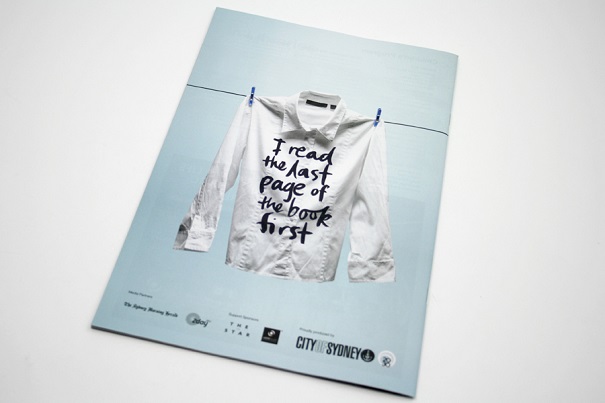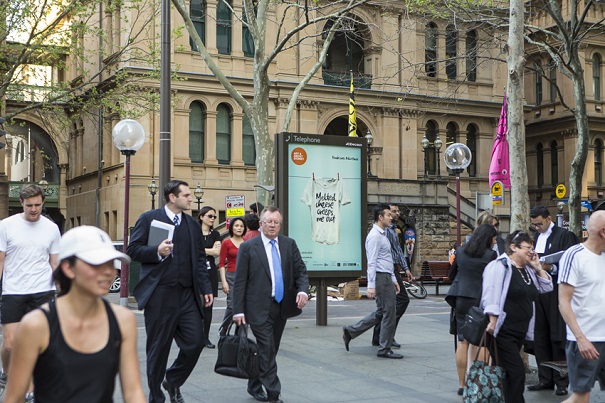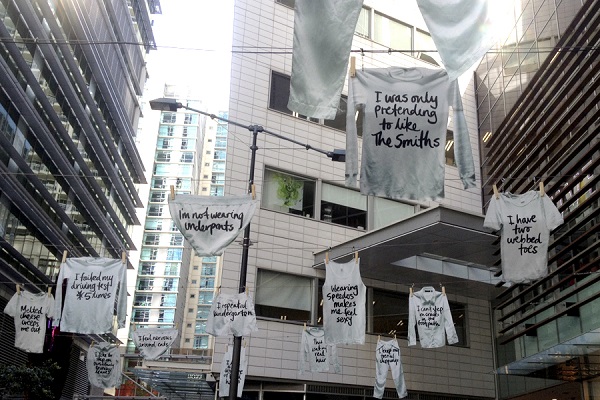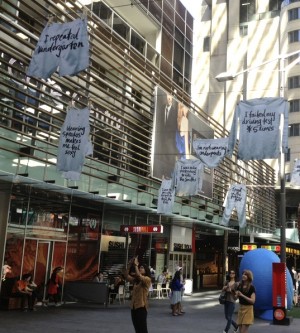Artist of the Week 10/16-10/22: Alphabet Studio Airs Out Sydney’s Dirty Little Secrets
GALO: One person revealed that they repeated kindergarten, another said they keep their toe nail clippings, while yet another wrote that “when times are tough, [they] turn to Oprah.” What has been the most surprising, horrifying or heartfelt secret that you have thus far seen as part of your exhibit?
AS: I think this project differs to a lot of other “secret-based projects” (think Frank Warren’s PostSecret) in its use of lightness and humor. We didn’t want viewers to feel uncomfortable or threatened when interacting with the project, but rather entertained and engaged. We hoped the “celebratory” tone would in turn help people to relate to the key messages presented and perhaps consider their own hidden quirks and secrets. In this sense, we didn’t include any particularly “horrifying” secrets, although failing one’s driving test five times is arguably horrifying! One of the most surprising secrets we obtained was to do with an anxiety created by triangles, although I’m sure this triangle-fearer is not alone!
GALO: Are people frequent participants of this exhibit, and those who do participate do they display feelings of shame or awkwardness as they write their secrets for the world to see, or do they see it as a therapeutic means? Also, if in the presence of others, do they find a secluded place to write out their thoughts (staying anonymous in turn) or do they remain in the open? In other words, what is the process like for them through your eyes as a bystander?
AS: All the secrets/confessions that formed part of the exhibition were collected and written prior to its public reveal. These messages were developed in house by all of us at Alphabet, from the experiences of our friends and family and with a bit of artistic license thrown in. The participants who had contributed secrets were unaware of their participation in the project until they saw their “quirk” out there in the open for the public to see (for example, my sister spotted “I’m a compulsive exaggerator” and instantly knew it was about her). In a sense, this takes the pressure off the audience and encourages taking more of a “back seat” involvement in the project. They’re able to interact with the laundry in a non-threatening way. This encourages people to participate in whatever way they feel comfortable: simply by looking, having a chuckle and moving on, or perhaps sharing an image on social media, publicly declaring their association with the secret.

A piece from the project City Lights, with the secret “I read the last page of the book first,” is displayed on the Art & About festival’s brochure. Photo Courtesy of: Alphabet Studio
GALO: You specialize in visual communication. City Lights, in retrospect, lets participants become the artist themselves, and allows viewers to personally relate to the secrets, whether by being empathetic to them, sharing the same ones, or simply knowing how it feels to have a secret and wanting to share it with someone, but being scared of the scrutiny that derives from it. Is interactivity in art an important element to you, especially in public art pieces, more so than the viewer just examining the art like one would do in a museum?
AS: Interactivity in art is extremely important, but I think it can come in many different forms. For example, examining art in a museum/gallery can still be interactive, as it asks the viewer to develop a personal response as they draw upon their own life experiences to provide a reaction to the work. Public art should go even further than this though, I think. It’s a far more accessible way for people to interact with art, opening up the potential for artists to stimulate conversation about key issues in a very raw and real way. What also adds to the rawness of public art is the way a viewer has no choice in participating in the artwork. A viewer decides to enter a museum or gallery, making a conscious decision to interact with the personal expression of artist. Public art removes this barrier of choice, which, in this case, forces viewers to engage with these highly personal secrets in their own individual way.

A piece from the project City Lights, with the secret “Melted cheese creeps me out,” is displayed on the streets of Sydney. Photo Courtesy of: Alphabet Studio.
GALO: Do you think all of the secrets are true or only have a layer of truth to them? Or do you think some are a figment of one’s imagination or the telling of someone else’s secret?
AS: While the secrets we developed are not all entirely “real,” I definitely think each would contain an element of truth for someone!
GALO: I am sure some readers are wondering, what will happen to the clothing with the written secrets after the exhibit comes to an end? Will they be disposed of, sold, reused in another exhibit or art project, or given away to either their owners or fans?
AS: As we hope to re-exhibit and further develop this project, I think we’ll be holding onto the clothing for the time being! Perhaps, one day the pieces of laundry can be returned to their rightful owners, if we can find them.

Pieces from the project City Lights are hung throughout the streets of Sydney. Photo Courtesy of: Alphabet Studio.
GALO: Where can viewers see this exhibit — is it located only in one area? And do you interchange the secrets on a daily basis or are the same ones left hanging and new ones are simply added in (if at all)?
AS: Fifteen city lights throughout the Sydney CBD and surrounds house a piece of laundry each. These will rotate and change throughout the duration of the Art & About festival, so you never know when a new secret may appear! A selection of pieces of laundry will also be hanging on a clothesline on the side of buses throughout the city. The full set of laundry is airing itself on a giant clothesline above World Square, a popular shopping and business precinct in Sydney CBD. This gives people the opportunity to view the project as a whole and interact with the full suite of secrets. As the dirty laundry project is being used as the hero imagery for the Art & About 2013 Festival, viewers can also see the project on the printed brochure cover and online at www.artandabout.com.au.
GALO: Apart from Sydney’s Art and About Festival, do you plan to take this public art showcase to other cities in Australia or perhaps to other parts of the world (for instance, did you think about coming to NYC and participating in Art in Odd Places next year)? And could you possibly share with us what you are working on next?
AS: Yes, we’d love to take the project further afield, and participating in New York’s Art in Odd Places does sound very enticing! The core concepts of the project cry out for its expansion, as there will never really come a day that we’ve “revealed all.” There will always be new secrets, thoughts and confessions to uncover, particularly if the project reaches an international level.
“City Lights” will be on display through October 20th, 2013 in Sydney, Australia as part of the Art & About Festival. For more information on the exhibit and its concrete whereabouts, please visit http://www.artandabout.com.au/festival-program/city-lights/.


